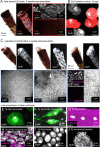Comment on 'A conserved strategy for inducing appendage regeneration in moon jellyfish, Drosophila, and mice'
- PMID: 37347531
- PMCID: PMC10287152
- DOI: 10.7554/eLife.84435
Comment on 'A conserved strategy for inducing appendage regeneration in moon jellyfish, Drosophila, and mice'
Abstract
Abrams et al. report that a simple dietary supplement is sufficient to induce appendage regeneration in jellyfish, fruit flies, and mice (Abrams et al., 2021). This conclusion is surprising because it was previously thought that flies and mice lack the capacity for regeneration after injury. We replicated the Drosophila experiments of Abrams et al. but did not observe any instances of leg regeneration. We also conclude that the "white blob" observed at the amputation site by Abrams et al. consists of bacteria and is not regenerated tissue.
Keywords: D. melanogaster; fruit fly; limb; regeneration; regenerative medicine; stem cells.
© 2023, Sustar and Tuthill.
Conflict of interest statement
AS, JT No competing interests declared
Figures



Comment in
-
Response to comment on 'A conserved strategy for inducing appendage regeneration in moon jellyfish, Drosophila, and mice'.Elife. 2023 Jun 22;12:e85370. doi: 10.7554/eLife.85370. Elife. 2023. PMID: 37347515 Free PMC article.
Comment on
-
A conserved strategy for inducing appendage regeneration in moon jellyfish, Drosophila, and mice.Elife. 2021 Dec 7;10:e65092. doi: 10.7554/eLife.65092. Elife. 2021. PMID: 34874003 Free PMC article.
References
-
- Bodenstein D. Contributions to the problem of regeneration in insects. Journal of Experimental Zoology. 1955;129:209–224. doi: 10.1002/jez.1401290110. - DOI
Publication types
MeSH terms
Grants and funding
LinkOut - more resources
Full Text Sources
Molecular Biology Databases

